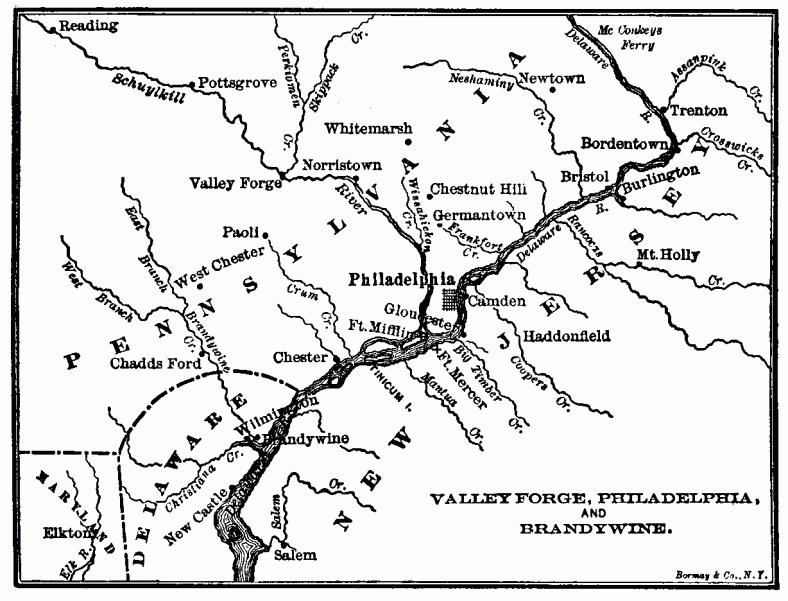On June 19, 1778, The Continental Army left Valley Forge.
 The army left Valley Forge more disciplined and as a better fighting force than when they marched in on December 19, 1777. Unfortunately, some 2,000 died during the Valley Forge encampment. Yet, the army persevered.
The army left Valley Forge more disciplined and as a better fighting force than when they marched in on December 19, 1777. Unfortunately, some 2,000 died during the Valley Forge encampment. Yet, the army persevered.
When the army left Valley Forge, they headed towards the British army, which left their winter quarters in Philadelphia towards New York. The Continental Army caught up with the British army at Monmouth, New Jersey where they showed their new mettle as a better fighting force in the Battle of Monmouth..
 The sacrifice of the Continental Army, George Washington and his generals, and all of those who supported them at Valley Forge is legendary. It is one of the things that inspired me to write my novel, Becoming Valley Forge. In walking through the Valley Forge Natioanl Park one day in 2010 with a friend, I was overcome with the feeling and the sacrifice of those six months. As we walked for miles, we came across commemorative markers from various groups like the Sons and Daughters of the American Revolution, local historical societies and counties, and groups such as Delta Sigma Theta Sorority, with their Patriots of African Descent in the Revolutionary War monument. We stopped at the striking statue of General Anthony Wayne, on whose land my home in Paoli is located, and when I returned home, I felt spirit of General Wayne and those who fought in and lived through the Paoli Massacre.
The sacrifice of the Continental Army, George Washington and his generals, and all of those who supported them at Valley Forge is legendary. It is one of the things that inspired me to write my novel, Becoming Valley Forge. In walking through the Valley Forge Natioanl Park one day in 2010 with a friend, I was overcome with the feeling and the sacrifice of those six months. As we walked for miles, we came across commemorative markers from various groups like the Sons and Daughters of the American Revolution, local historical societies and counties, and groups such as Delta Sigma Theta Sorority, with their Patriots of African Descent in the Revolutionary War monument. We stopped at the striking statue of General Anthony Wayne, on whose land my home in Paoli is located, and when I returned home, I felt spirit of General Wayne and those who fought in and lived through the Paoli Massacre.
At every spot, honoring this regiment or that, I wondered–what was it like for the people in those regiments? What was it like for the people who lived here when those regiments descended on this area during the Philadelphia Campaign and its battles–Brandywine, Germantown, Paoli, Barren Hill–and its encampments, like Rebel Hill and Gulph Mills, where I grew up? What happens when 11,000 soldiers come to your backyard? What happens when you are in the midst of a war when you are just a farmer or a businesswoman just trying to make a living? What happens when the British army descends on your town, bringing their repression straight to your front door, stealing your food, harming your family?
These were the questions that all made up the sum and substance of that fiction writer’s question–what if? What if the war came to your backyard? What would that be like? So, I tried to answer those questions in Becoming Valley Forge through the eyes of a family of patriot farmers, spies and soldiers from Paoli; a blacksmith, then soldier, patriot from Rebel Hill; a blacksmith, then soldier, former slave from Rebel Hill who purchased his freedom and sees the war as a means to an end to purchase his fiancée’s freedom from a nearby plantation; a brothel owner in Germantown who was disowned by her Paoli family and who services the chief commander of the British Army during their occupation of Philadelphia; the Oneida Indians who come to Valley Forge to assist their friend, General Washington; and others.
Becoming Valley Forge is my homage to the Revolutionary War and those who fought in and supported it. I appreciate their sacrifices for our freedom. And, as an African American woman, I had to keep it real and address the dichotomy of people who fought for the freedom of their country while so many African Americans who lived there were not free. I wanted to honor the contributions of the Oneida Indians and all of the different types of people who “became Valley Forge”–not just the white male soldier who most of us learned about in history class.
I thank God for those with whom my novel has resonated with positive reviews from the Midwest Book Review (read full review here, too) and the Historical Novel Society and with winning the Regional Fiction category in the Next Generation Indie Book Awards. And I thank all of my readers who took the time and spent the money to read this novel. I also thank the Museum of the American Revolution and the Cabin Shop at the Valley Forge Park Memorial Chapel for carrying my novel, so pick up a copy of you visit there this summer.
So, as the Continental Army moved out of Valley Forge and on to other things, I’m going to do the same. I’ll blog here occassionally about Becoming Valley Forge, but I won’t blog regularly until we get closer to September 11–when, in 1777, the Continental Army began the Philadelphia Campaign with the Battle of Brandywine, and when Becoming Valley Forge begins.
If you read Becoming Valley Forge during the summer, I’d love to hear from you. Please feel free to email me at svance@theelevatorgroup.com.
Peace.
Sheilah Vance

Reblogged this on Sheilah Vance.
LikeLike